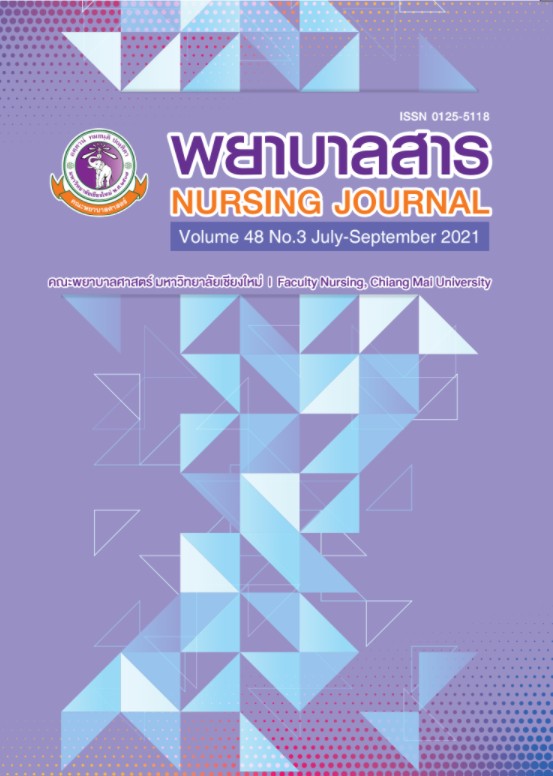Development of a Nursing Model for Critically ill Neonate and Pediatric Patients Receiving Heated Humidified High Flow Nasal Cannula (HHHFNC), Nakornping Hospital
Keywords:
High flow oxygen therapy, Neonate and Pediatric Intensive Care, Nursing modelAbstract
This developmental research aims to study the outcomes of a nursing model for critically ill neonate and pediatric patients receiving Heated Humidified High Flow Nasal Cannula (HHHFNC) at Nakornping Hospital during August 2020 to April 2021. The purposive sampling consisted of a developing team of 10 members, 45 professional nurses, 77 critically ill neonate and pediatric patients, 1day-15 year. The research was conducted in 4 phases: 1) situation analysis, 2) nursing model development, 3) application of the developed model, and 4) outcome evaluation. The research instruments consisted of group discussion questionnaires and a nursing model for critically ill neonate and pediatric patients receiving HHHFNC. The data collection tools consisted of: 1) a personal data questionnaire for nurses and patients, 2) a nursing practice observation form, 3) an outcome record form, 4) a nursing satisfaction questionnaire, and 5) a knowledge assessment form. All passed content validity = 1. The nursing satisfaction questionnaire and the nursing practice observation form, with reliability by Cronbach’s alpha coefficient, were 1 and 0.86, respectively. The knowledge assessment form, with reliability by Kuder-Richardson (KR-20), was 0.75, and the average power of all items was 0.49. Data analysis, descriptive statistics and inferential, paired t-test, independent t-test, chi-square test, exact probability test. Qualitative data using content analysis.
The results revealed that the nursing model for critically ill neonate and pediatric patients receiving HHHFNC consisted of: 1) nursing before HHHFNC, 2) nursing during HHHFNC, and 3) nursing after HHHFNC. The mean scores of nurse knowledge after development were statistically significantly higher than before (p < 0.001). The overall nurses’ satisfaction was at the highest level (95.55 %). The success of HHHFNC before development was 82.50., 94.59 after development, nasal cannula slippage, pleural air leaks, hospital-acquired pneumonia. The decrease was not statistically significant. The nose lesion was significantly different (p < .05), and the mean length of stay in the intensive care unit decreased from 15.25 days to 6.83 days with statistical significance (p < .05).
The developed nursing model is appropriate for increasing the quality of nursing care. Nursing administrators should use the model to improve the quality of nursing care for patients receiving HHHFNC.
References
Debbie, F. (2019). The effect of high flow nasal cannula weaning protocol on decreasing length of stay in pediatric intensive care (Doctor of nursing practice). University of Louisville School of Nursing.
Eaksilp, C. (2015). Treatment of high flow nasal cannula in children. in Dusit Sataworn, Kanchit Piyavejwatarat, Sahodol Panyathaworn, Editor. The Acute Care. First Edition, Bangkok: Beyond Enterprise, 387-396.
Frat, J., P., Coudroy, R., Marjanovic, N., & Thille, A, W. (2017). High-flow nasal oxygen therapy and noninvasive ventilation in the management of acute hypoxemic respiratory failure. Annual of Translational Medicine, 5(14) 289 - 297.
Günlemez, A., Isken, T., Gökalp, A. S., Türker, G., & Arisoy, E. A. (2010). Effect of silicone gel sheeting in nasal injury associated with nasal CPAP in preterm infants. Indian Pediatrics, 47, 265-267.
Hegde, S., & Prodhan, P. (2013). Serious air leak syndrome complicating high-flow nasal cannula therapy: A report of 3 cases. Pediatrics, 131(3), e939-e944.
Khamman, S., Surimuang, M., & Asavapalangkul, A. (2020). The effect of using a high flow nasal cannula non-invasive ventilator in adult patients. Mae Sot Hospital. 1-10. (in Thai)
Mayfield, S. A. (2015). Evidence for the use of high flow nasal cannula therapy for respiratory management in pediatric units (Doctor of Philosophy). The University of Queensland School of Nursing, Midwifery and Social Work.
National Health and Medical Research Council. (1998). A guide to the development, implementation and evaluation of clinical practice guidelines. Australia: National Health and Medical Research Council.
Niyomsats, K., Niyomkar, S., & Lamchang, S. (2020). Factors related to caregiver participation in treatment decision-making for children with cancer receiving chemotherapy. Nursing Journal, 47(1), 66-76. (in Thai)
Nugboon, M., Santati, S., & Preutthipan, A. (2020). The development and evaluation of clinical nursing practice guideline for modified high flow nasal cannula system in pediatric patients. Thai Journal of Nursing and Midwifery Practice, 7(2), 25-40. (in Thai)
Nursing information. (2017-2019). Annual report of neonatal & pediatric intensive care Unit. Nakornping Hospital, Chiang Mai Province.
Pornmesri, A., Chintapanyakun, T., Mettraipan, P., & Sriphraram, K. (2019). Effectiveness of development in clinical nursing practice guidelines for child patients received heated humidified high flow nasal cannula in samutprakarn hospital. Nursing Journal of the Ministry of Public Health, 29(3), 118-130. (in Thai)
Sajith, K., & Bala, R. (2016). Humidified high-flow nasal cannula oxygen therapy in children-a narrative review. Journal of pediatric critical care, 3, 29-34.
Surimuang, M., & Asavapalangkul, A. (2020). Effectiveness of coaching on adherence towards guidelines for prevention of ventilator-associated pneumonia and clinical outcomes. Ramathibodi. Nursing Journal, 26(2), 138-154. (in Thai)
Sutalangka, M., Urharmnuay, M., & Chotibang, J. (2017). Maternal care and related factors in developmental care of preterm infants. Nursing Journal, 44(1), 50-61. (in Thai)
Syananondh, K. & Deesomchok, A. (2016). Comparison of heated humidified high flow nasal cannula (HHHFNC) and nasal continuous positive airway pressure (NCPAP) for post extubation respiratory care in preterm infants. Buddhachinaraj Medical Journal, 33(2), 156-167. (in Thai)
The Joanna Briggs Institute. (2014). Joanna Briggs Institute Reviewers Manual:2014 Edition. The Joanna Briggs Institute, Australia.
Tiasawat, U., Saensom, D., Namuangchan, A., Tansura,S., Boonloy, Y., & Songserm, A. (2017). Development of a clinical nursing practice guideline for mechanically ventilated patients in critical care department, Khon Kaen Hospital. Journal of Nursing and Health Care, 35(1), 194-206. (in Thai)
Van Loo, M., & Sottiaux, T. (2016). High flow nasal cannula oxygenation for adult patients in the ICU: A literature review. Acta Anaesthesiologica Belgica, 67, 63-72.
Vareesunthorn, I., & Preutthipan, A. (2018). Modified high-flow nasal cannula in young children with pneumonia: A 3-year retrospective study. Pediatric Respirology and Critical Care Medicine, 2(3), 45-50.
Downloads
Published
How to Cite
Issue
Section
License
บทความที่ได้รับการตีพิมพ์เป็นลิขสิทธิ์ของวารสารพยาบาลสาร
ข้อความที่ปรากฏในบทความแต่ละเรื่องในวารสารวิชาการเล่มนี้เป็นความคิดเห็นส่วนตัวของผู้เขียนแต่ละท่านไม่เกี่ยวข้องกับมหาวิทยาลัยเชียงใหม่ และคณาจารย์ท่านอื่นๆในมหาวิทยาลัยฯ แต่อย่างใด ความรับผิดชอบองค์ประกอบทั้งหมดของบทความแต่ละเรื่องเป็นของผู้เขียนแต่ละท่าน หากมีความผิดพลาดใด ๆ ผู้เขียนแต่ละท่านจะรับผิดชอบบทความของตนเองแต่ผู้เดียว






